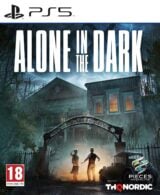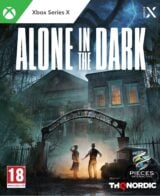Alone in the Dark is another frustrating reboot for the classic horror series
A promising setup is let down by repetitive puzzles, poor combat and frequent glitches
- Creative director and writer
- Mikael Hedberg
- Key Credits
- Rikard Ryberg (Art director), Claes Johansson (Producer)

Contrary to how it may appear in certain other circles, not all reviewers take pleasure in writing negative reviews of games.
Every time a new release underwhelms, we share criticism acutely aware that a team of people worked on that game, and that a low-scoring review can have an actual impact.
If it pains our heart to criticise a game for this reason, the Deluxe Edition of Alone in the Dark really jams the stake in and gives it a little twist. It includes a fantastic commentary mode in which a large number of floating microphones are dotted around the game, and selecting each one lets you hear different developers explain in great detail how certain scenes, story beats, environments or characters were created.
It’s clear from these commentaries that a great deal of love and went into the making of this game, which is why it’s all the more disappointing that it really fails to strike a chord on any level.
The 2024 version of Alone in the Dark is the third attempt to reboot Infogrames’ iconic 1992 survival horror classic, following similar releases in 2001 and 2008. This one’s a lot closer to the original, and while it doesn’t tell the exact same story its 1920s Louisiana setting, its use of the same characters and its numerous references and easter eggs make it clear that the first game is the most direct influence.
Buy Alone in the Dark (PS5)

Buy Alone in the Dark (Xbox Series X)

Detective Edward Carnby (played by Stranger Things’ David Harbour) has been hired by Emily Hartwood (Killing Eve and The Last Guy’s Jodie Comer) to accompany her on her search for her uncle Jeremy, who’s gone missing. Jeremy’s last whereabouts were at the Deserto mansion, a home for the ‘mentally fatigued’, and so begins a trip to find out what’s going on.
In a similar style to the early Resident Evil games, players can choose to play as either Edward or Emily, with each providing a different experience. Without wishing to spoil anything, the game encourages multiple playthroughs – while it initially seems that both characters are following the same story beats, with the only difference being that cutscenes play out differently, both plots do eventually branch off in very different directions for a while.
Despite the over-the-shoulder viewpoint giving the impression that it plays like a modern adventure, Alone in the Dark is clearly designed with ‘90s survival horror sensibilities in mind. This is very much a game where puzzles are the central focus, and this is where things start to go downhill.
There are two ‘player guidance’ options available, called Modern and Old-School. The latter gives the players no help whatsoever, leaving them to figure everything out for themselves. This would be fine were the puzzles not often buried under reams of exposition—many of the solutions lie in the books, notes, and various other text sources found lying around the house.
These are rarely Resident Evil style “hey buddy, the locker combination is 6-3-4-1” memos. Instead, they’re often lengthy prose, providing lots of extraneous information with one small clue hidden in one sentence. Sometimes, there aren’t even any clues there at all, meaning some of these are purely for lore purposes.
Changing the player guidance option to Modern alleviates some of these issues, but only to an extent. Now, when you read text, the game highlights the words or phrases that help you with puzzles. On top of this, when you collect a key and go to the in-game map, it highlights which doors you can unlock, and it also occasionally gives you objectives in the corner of the screen so you know what you’re doing next.
Make no mistake, however, turning on Modern guidance is far from a hand-holding exercise, and the majority of players will still find themselves wandering around in frustration, trying to find more clues to help them solve some of the game’s more convoluted puzzles.
It also doesn’t help that the puzzles themselves are on the repetitive side. Early in the game, the player obtains a magical talisman which can transport them to different locations, which they do by placing it on certain areas and setting a three-digit code on it. What this essentially means is that you’re regularly looking for three-digit codes: this is an overused survival horror trope at the best of times, but when it’s reused in numerous instances here, it just feels lazy.
Naturally, it’s not all stumbling through a mansion in a daze while looking for keys, shards of broken plates and valve handles. Eventually, you’ll come across the game’s monsters, and they’re similarly underwhelming. One early encounter can easily result in you being pinned against a wall and unable to escape, shoot, reload or regain health, meaning there’s a good chance your first introduction to the game’s combat is one of frustration rather than fear.
It continues to be sloppy throughout, with questionable enemy AI and annoying gunplay, which requires you to stand still for a while for more accurate shots, something that isn’t always possible when you’re being chased at jogging speed by a lumbering nondescript slime monster thing. Monster bugs and bats appear later and are annoying in their own special way.
“One early encounter can easily result in you being pinned against a wall and unable to escape, shoot, reload or regain health, meaning there’s a good chance your first introduction to the game’s combat is one of frustration rather than fear.”
If you don’t want to resort to firearms, there are a variety of melee weapons you can collect. These are oddly effective but also prone to breaking (we swear a pickaxe should be able to withstand more than a few cracks off a monster’s head), or you can resort to the glass bottles liberally dotted around, though tossing these seems even less effective.
THQ Nordic is clearly putting its stock in the game’s main monster, the Dark Man, hence its decision to include a 10” statue of him as part of the game’s Collector’s Edition. While the character design is interesting, your encounters with him (which are few and far between) are in no way intimidating, and are instead infuriating stealth-lite affairs where you have to navigate an area without walking in front of him.
Should you fail and get too close, your character simply falls to the floor in front of him and a Game Over message appears. Fear of the unknown is a powerful thing in a horror game, but once you realise Dark Man death scenes are so impossibly tame, any sense of tension or terror is immediately extinguished.

On top of the confusing exploration, the shonky combat and the general lack of frights, Alone in the Dark is also riddled with bugs. The game was originally set to release in October, but was held back until January allegedly to avoid releasing in a busy month, then delayed again until March “to avoid any potential crunch over the Christmas holidays”. The latter suggested a crowded release schedule wasn’t the only reason for its delay, and that perhaps it wasn’t quite polished enough. On the evidence of what we’ve played, it still isn’t.
Of the game’s Quality and Performance modes, the latter is preferred, because Quality mode frequently fails to hit 30 frames per second and can get juddery at certain moments. Even in Performance mode, however, which aims for 60fps, there are some sections where the game seemingly nosedives. At one point during an open area near the end of the game, the whole thing just collapsed, and the frame rate hit what had to be single figures for a while.
It should be noted that THQ Nordic tells us some issues will be fixed in a day one patch, including performance and stability, so it remains to be seen how much of this will reach players. A lot of the things we encountered weren’t listed in the notes it provided us, however. On three separate occasions, we got stuck in the scenery and had to reload. At one point, we opened a door, and our character suddenly jittered, shrunk down to a glitching mess, then popped back to normal again (which was genuinely the scariest part of the game for us).
“On three separate occasions, we got stuck in the scenery and had to reload. At one point, we opened a door, and our character suddenly jittered, shrunk down to a glitching mess, then popped back to normal again (which was genuinely the scariest part of the game for us).”
A later puzzle involving giant vines wrapping around a bridge was undermined when the vines flickered wildly as they appeared, and each time, we chopped at them. Some killer bats attacked us around the vines, and as we killed one, it ‘landed’ in mid-air. Then, as we attempted to leave the bridge, we got stuck on a piece of the floor and had to reload our save. No game is immune from glitches here and there, but Alone in the Dark certainly has more than its fair share. While initially funny, the lack of care and attention starts to become irritating.
There’s something to Alone in the Dark that doesn’t make it entirely irredeemable. There’s still a B-movie charm running through it, from the awkward performances (Harbour and Comer get pass marks, but they’re dealing with some abysmal dialogue at times) to the utterly nonsensical plot, which, two playthroughs later, we still don’t really have much of a grasp of.
There are some clever ideas in there. Even though the talisman is overused, the way it lets you walk through a door in the mansion and suddenly find yourself in a completely different street, or swamp, or some other location we don’t want to spoil, is a neat effect.
There’s still clear love present in the art direction, the nods to the original game (especially in one section near the end) are a nice touch for those familiar with it, and one scene in the final act involving a tree is so ridiculously over-the-top, and comes out of nowhere, we admittedly laughed out loud: with it, not at it.
It’s just that even though the game’s virtues are clearly in there, so much of the gameplay feels like it’s trying its best to get in the way of you enjoying them. From the abstract puzzles dampening the exploration to the poor combat undermining enemy encounters, at nearly every beat, we found ourselves thinking, “This would be good, were it not for that”.
Apologies, then, to the developers involved with this game. We don’t know if the numerous issues we encountered are the result of a game that couldn’t be delayed any further, and perhaps with more time some of the technical issues could have been ironed out.
On a structural level, however, there are design choices here that we simply couldn’t get along with, and as such, we now find ourselves hoping that maybe one day – likely in the distant future – a fourth Alone in the Dark reboot will nail it.
Alone in the Dark's promising atmosphere is let down by annoying and repetitive puzzles, poor combat and frequent glitches. There's a good game in there somewhere but you have to put up with a lot of frustration to find it.
- Atmospheric locations and a clever portal gimmick
- David Harbour and Jodie Comer do their best with the material
- Painfully convoluted and repetitive puzzle solving
- Combat is sloppy and enemy AI is weak
- Riddled with bugs and performance issues
- The plot can get nonsensical at times





















